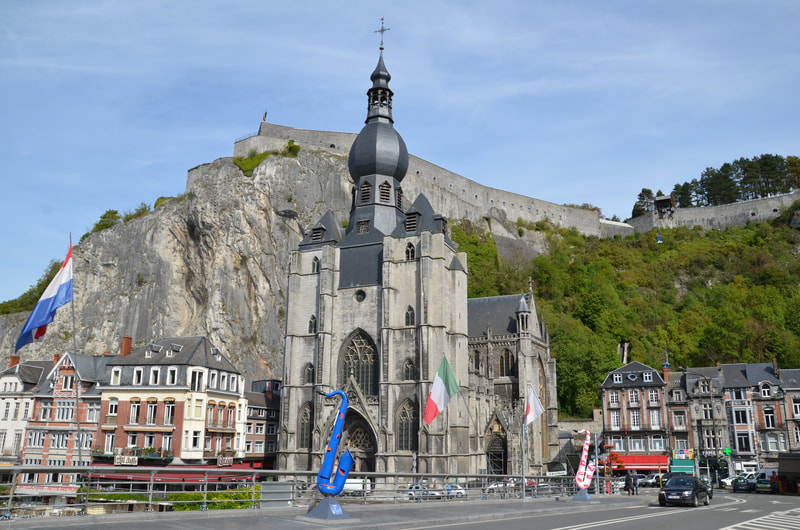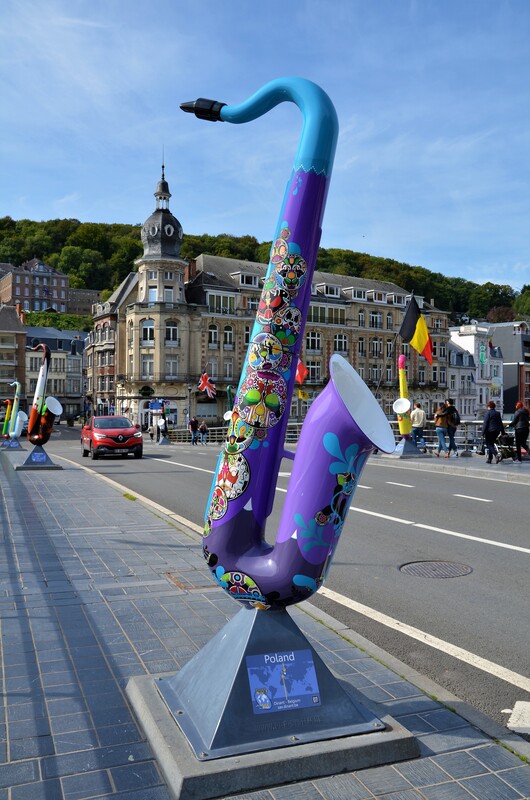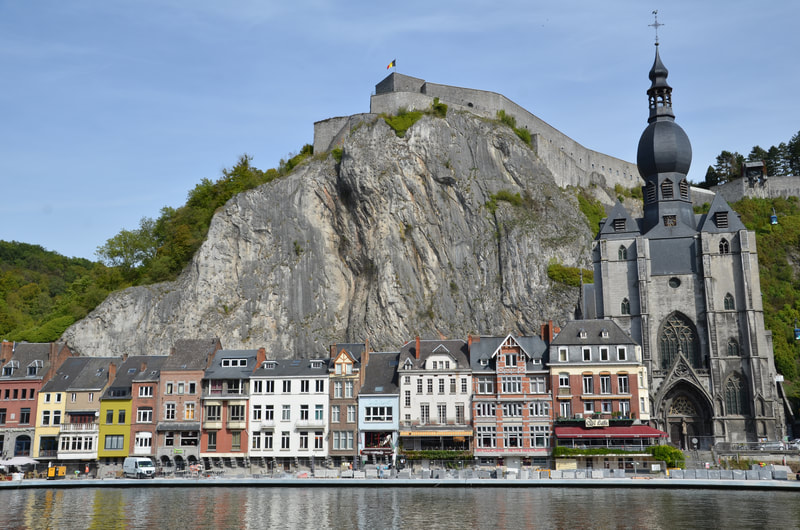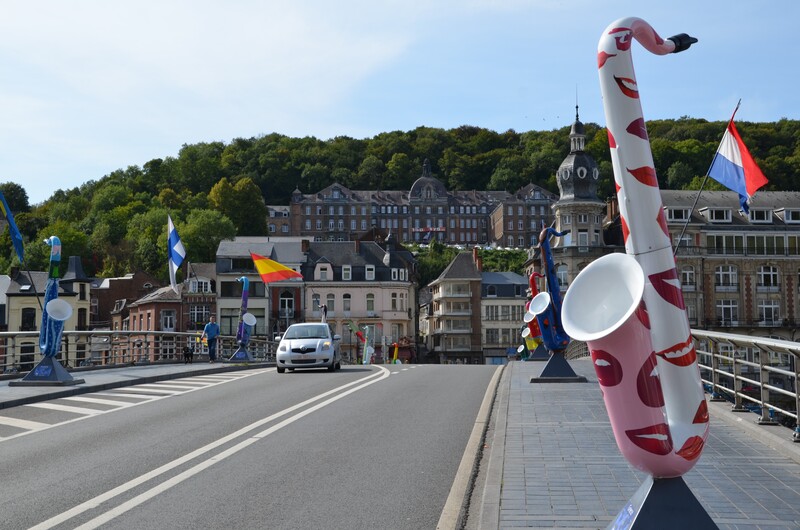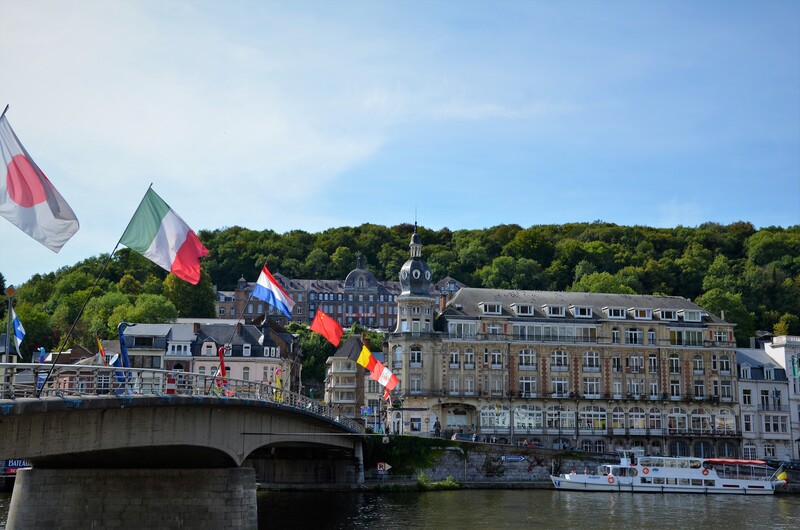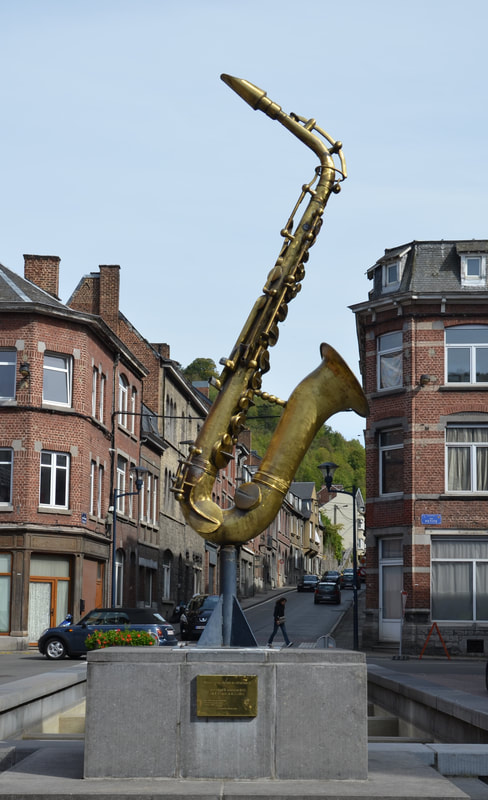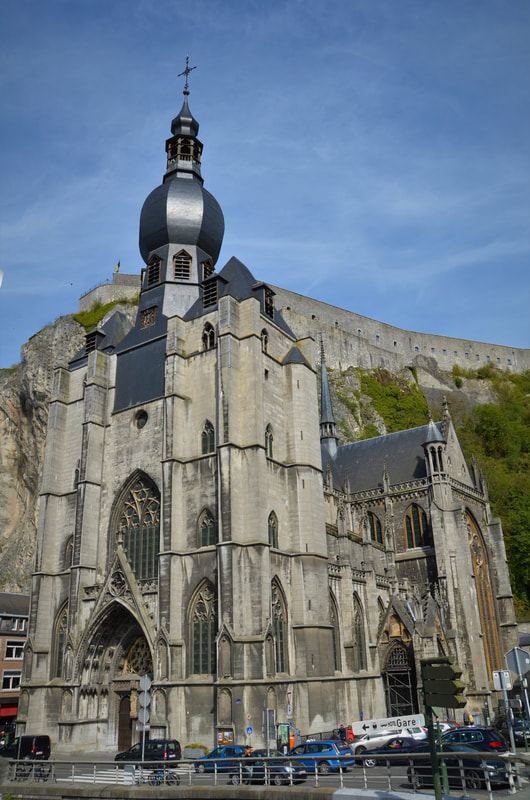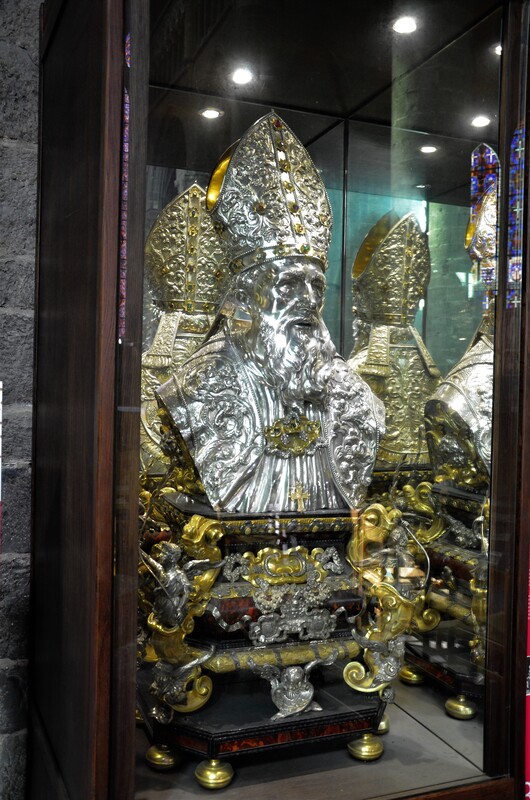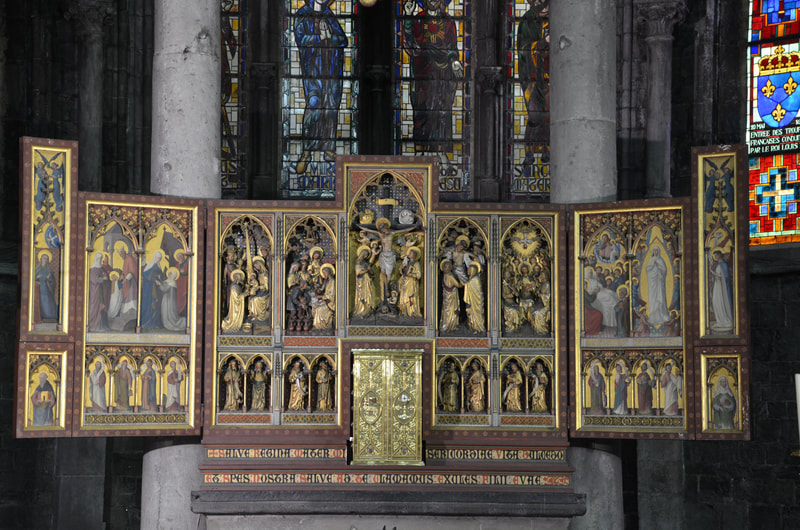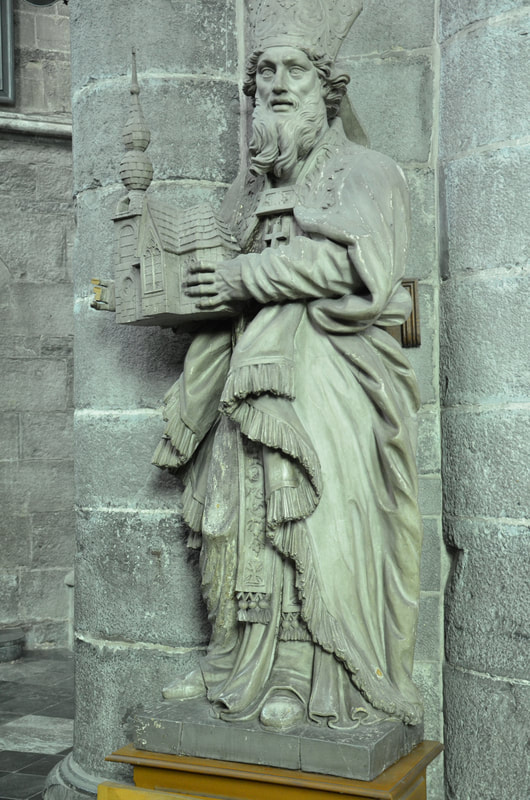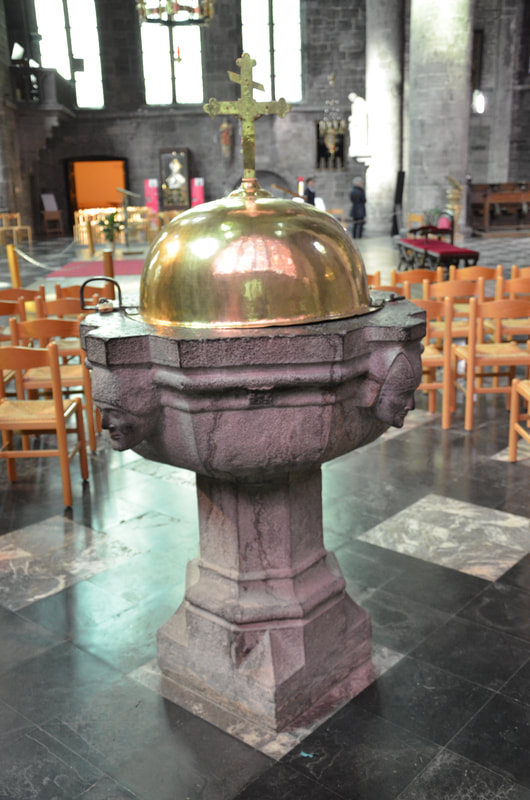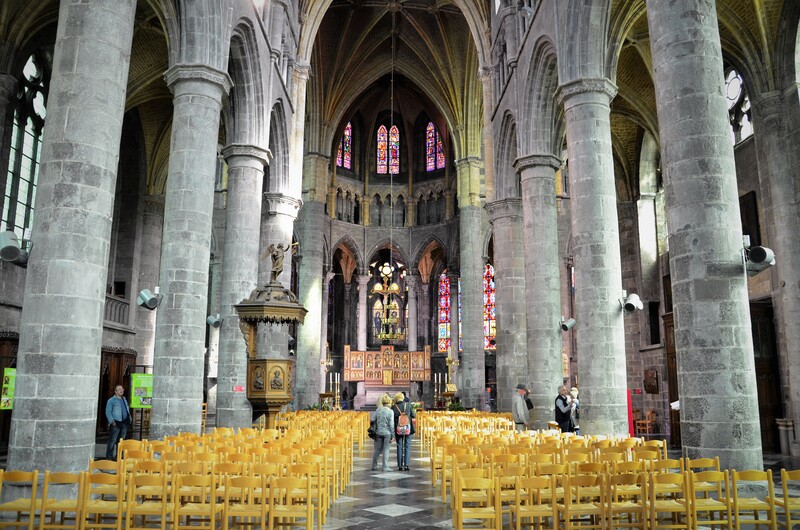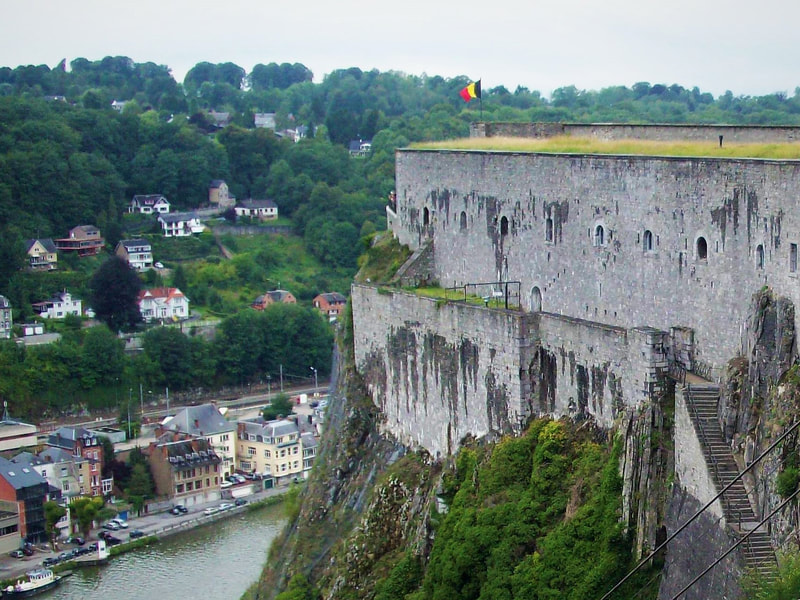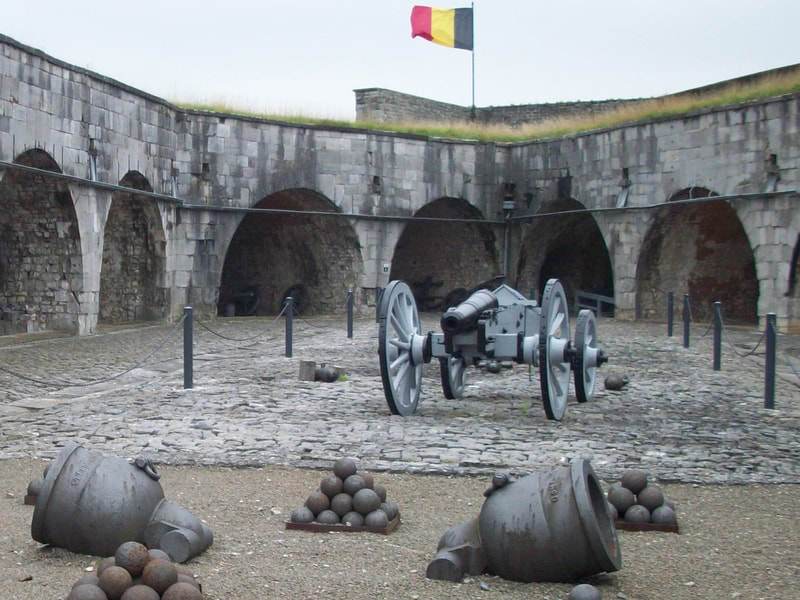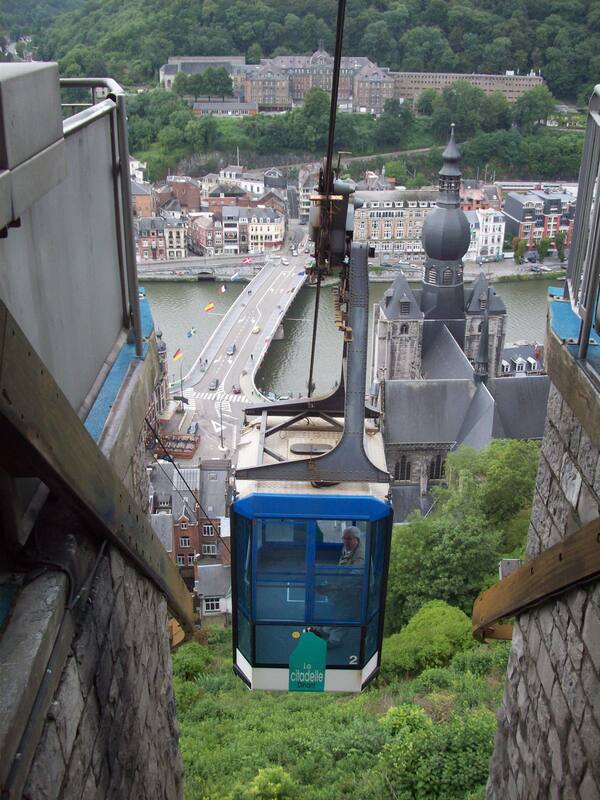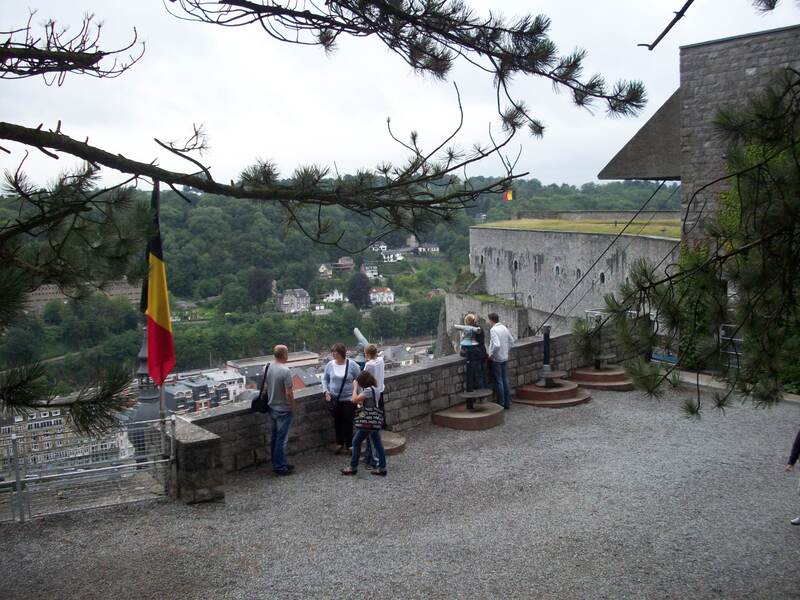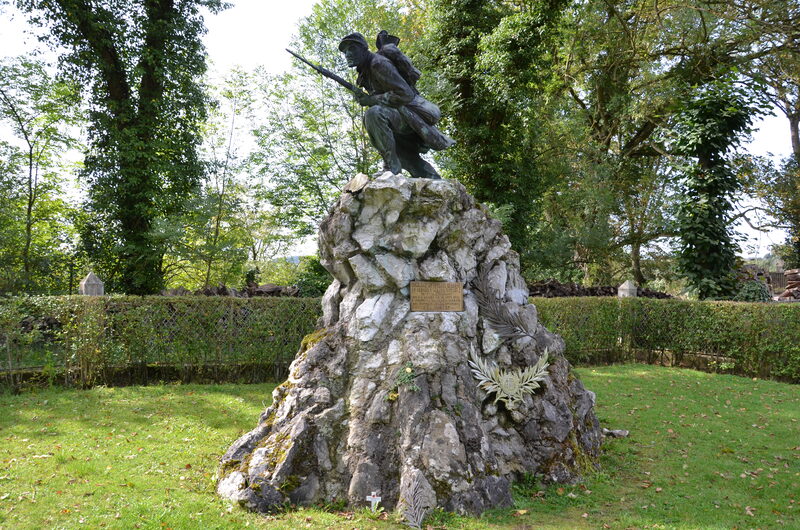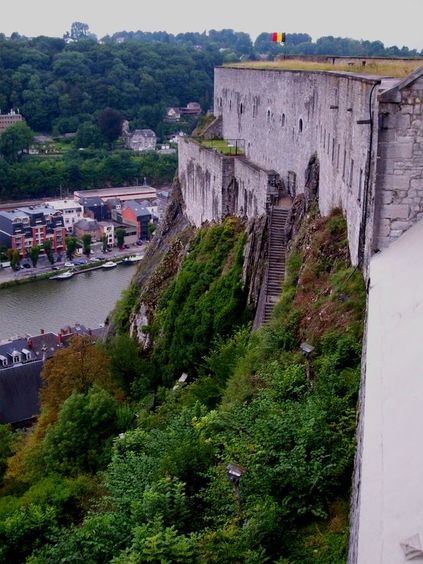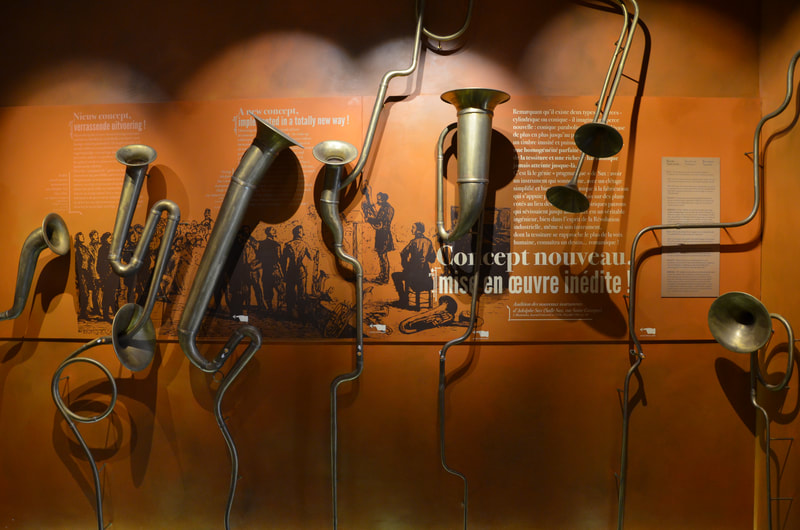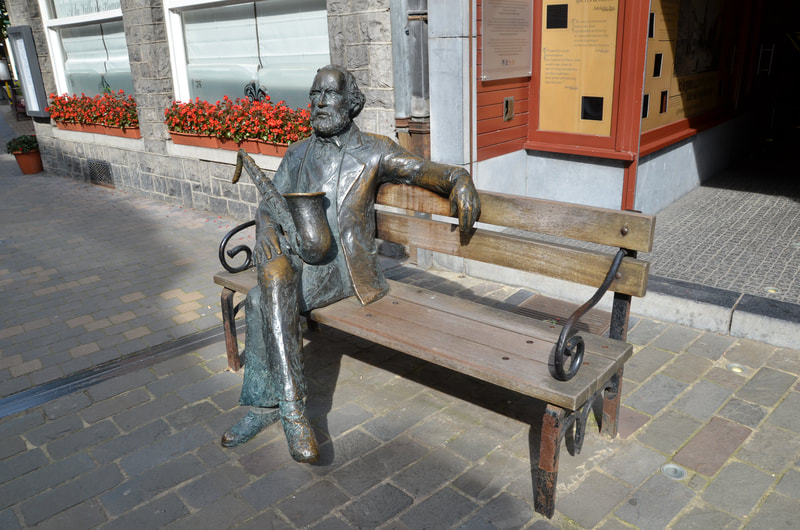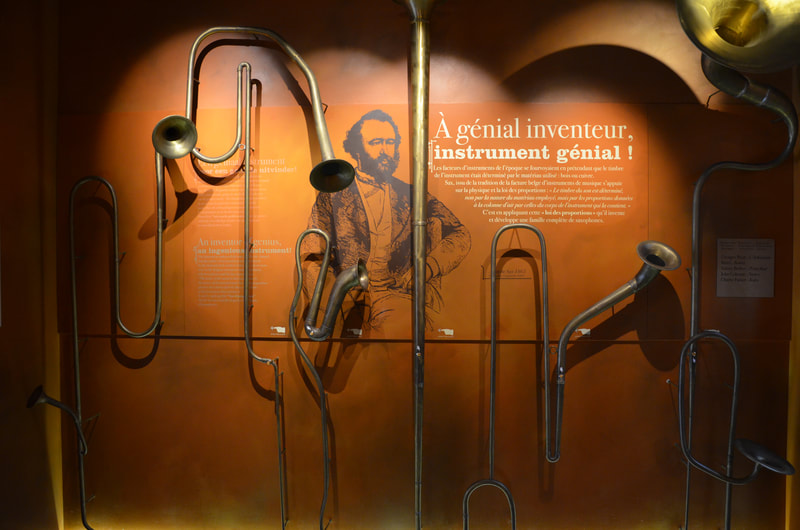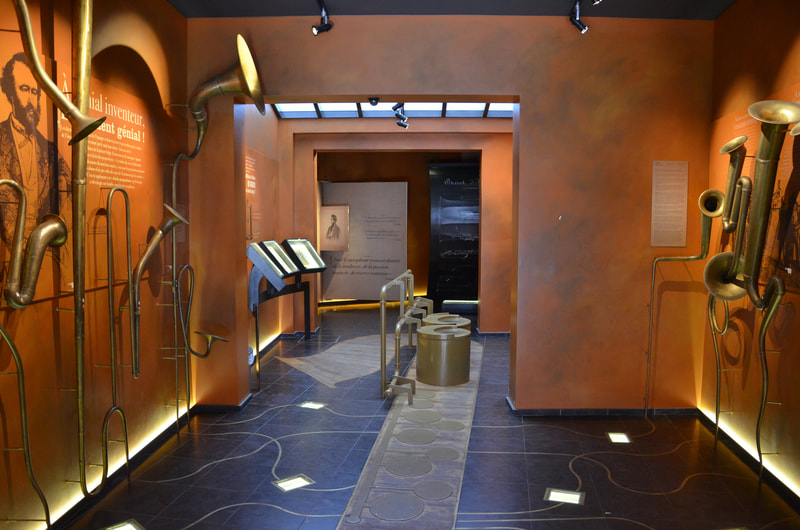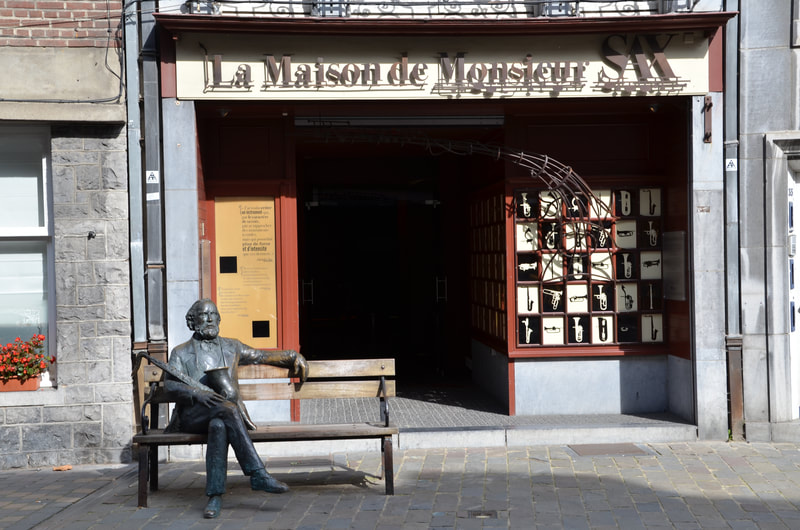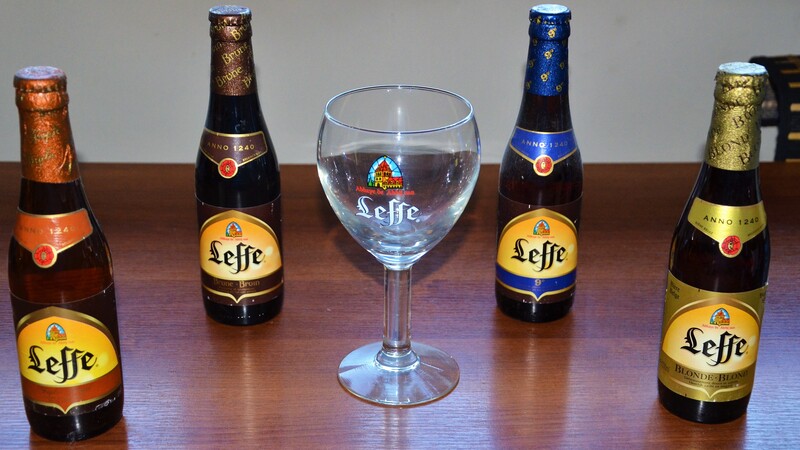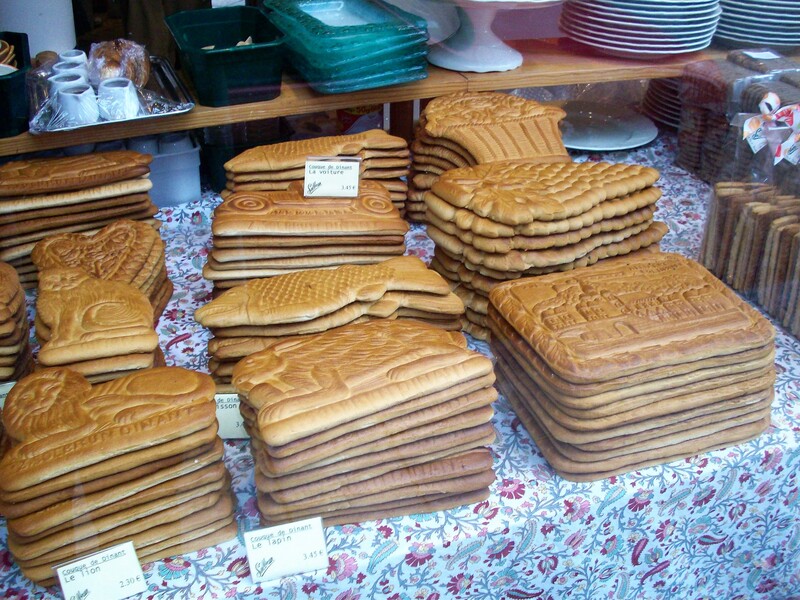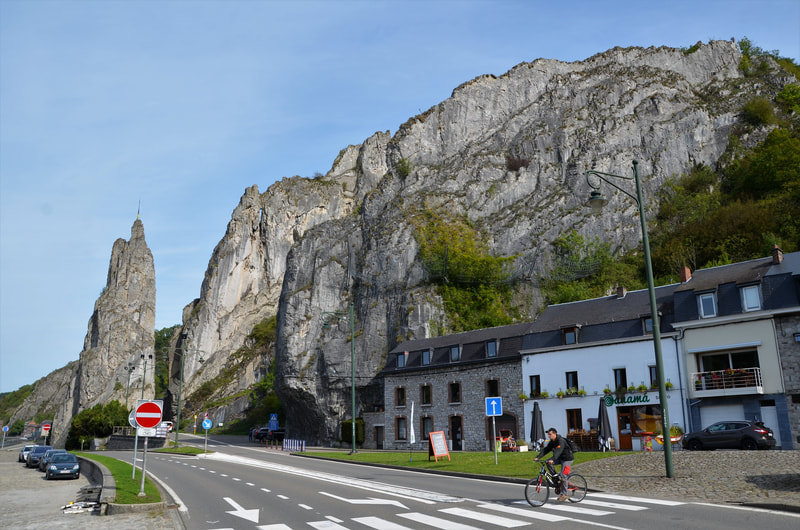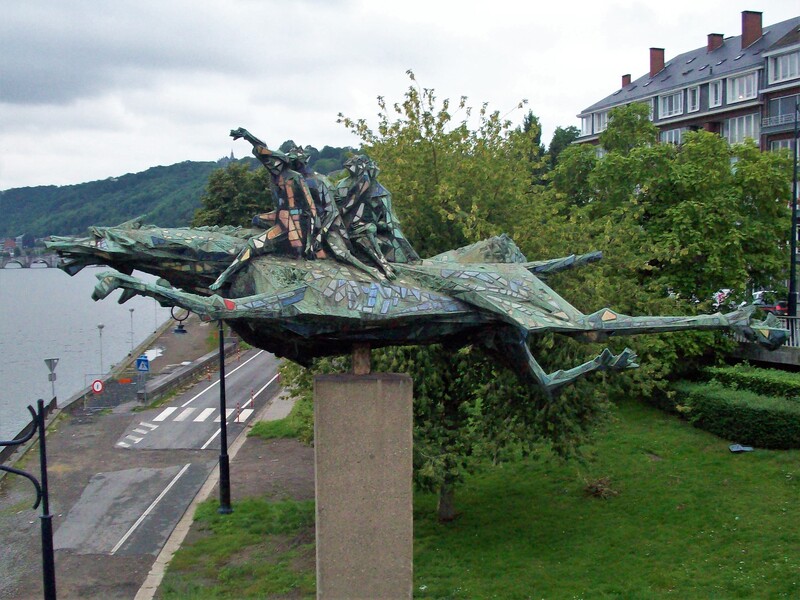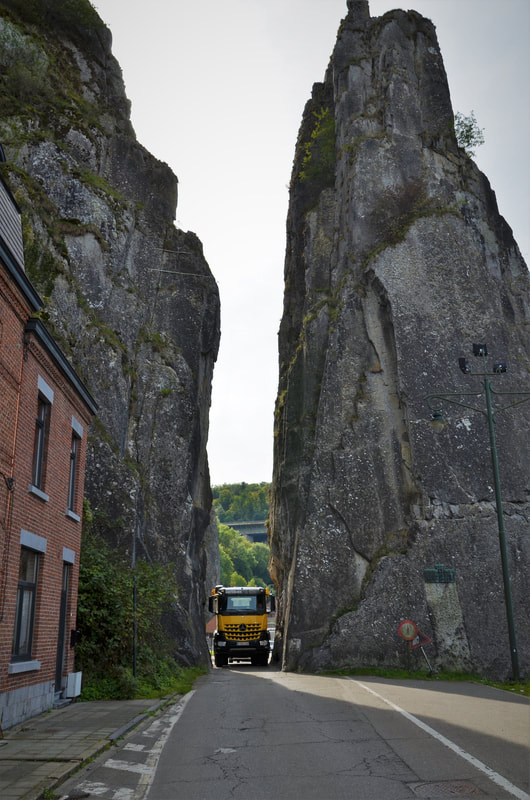|
vertical divider
Dinant |
is a historic city situated in a beautiful area between stone cliffs and the river Meuse. This is a very important point on the tourist map of Wallonia. Above the city buildings, on the banks of the Meuse, there is a magnificent church with an onion-shaped dome. Another equally popular monument is the citadel standing on top of the rock. Lovers of rock climbing come here for the magnificent cliff. In the summer, especially on weekends, cruise ships, kayaks and pedal boats sail the river.
|
Church of the Blessed Virgin Mary
W miejscu, na którym stoi obecna świątynia w latach 1000-1200 powstawał kościół w stylu romańskim. Kiedy w 1227 roku odłamek skały zniszczył wieżę, kościół został częściowo przebudowany w stylu gotyckim. Rekonstrukcja trwała aż do wieku XIV. Ta nowa konstrukcja jest nadal dominującym stylem w prezbiterium oraz w południowej części transeptu.
W roku 1466 książę Burgundii Filip Dobry wraz z synem Karolem Odważnym ukarali mieszkańców Dinant, podkładając ogień w mieście. Powodem tej zemsty było powstanie, które wszczęli mieszkańcy. Około 800 z nich wrzucono do rzeki Mozy, a część kościoła Najświętszej Marii Panny została zniszczona. Po kilku latach rozpoczęto odbudowę świątyni w nieznacznie zmienionym stylu. Symbolem nowego początku, powtórnych narodzin stała się chrzcielnica umieszczona w baptysterium.
W roku 1466 książę Burgundii Filip Dobry wraz z synem Karolem Odważnym ukarali mieszkańców Dinant, podkładając ogień w mieście. Powodem tej zemsty było powstanie, które wszczęli mieszkańcy. Około 800 z nich wrzucono do rzeki Mozy, a część kościoła Najświętszej Marii Panny została zniszczona. Po kilku latach rozpoczęto odbudowę świątyni w nieznacznie zmienionym stylu. Symbolem nowego początku, powtórnych narodzin stała się chrzcielnica umieszczona w baptysterium.
Originally, the church should have had two majestic towers. Ultimately, however, this plan was not implemented, and the temple was crowned with one 68-meter-high onion-shaped tower, located above the main entrance. Initially, this strange structure was to crown the house of city councilors, but it turned out to be too heavy, so it was placed on top of the collegiate church.
Inside the temple there are interesting dinanderie (decorative brass objects, made in the vicinity of Dinant). In the late Middle Ages, Dinant became a center for the manufacture of copper objects.
The altar is part of an important renovation of the collegiate church from the second half of the 19th century, the aim of which was to give it its original, Gothic character. The whole is inspired by altars carved in Brabant in the 15th and 16th centuries. The treasure of the collegiate church is also a wonderful reliquary containing the remains of the patron saint of the city, Saint Perpetus. Until the 1960s, the reliquary was carried through the streets of Dinant in a procession on 15 August. The collegiate church also has one of Europe's largest neo-Gothic stained glass windows depicting the history of salvation. Gustave Ladon, an artist from Ghent, created this work in the year 1903, in the style of thirteenth-century Gothic stained glass. Every Sunday, from June to August, at 16.30 an organ concert is held here.
Inside the temple there are interesting dinanderie (decorative brass objects, made in the vicinity of Dinant). In the late Middle Ages, Dinant became a center for the manufacture of copper objects.
The altar is part of an important renovation of the collegiate church from the second half of the 19th century, the aim of which was to give it its original, Gothic character. The whole is inspired by altars carved in Brabant in the 15th and 16th centuries. The treasure of the collegiate church is also a wonderful reliquary containing the remains of the patron saint of the city, Saint Perpetus. Until the 1960s, the reliquary was carried through the streets of Dinant in a procession on 15 August. The collegiate church also has one of Europe's largest neo-Gothic stained glass windows depicting the history of salvation. Gustave Ladon, an artist from Ghent, created this work in the year 1903, in the style of thirteenth-century Gothic stained glass. Every Sunday, from June to August, at 16.30 an organ concert is held here.
Citadel
Kolejnym bardzo ważnym zabytkiem jest potężna cytadela, usytuowana ponad kościołem i dominująca nad całym miastem. Wybudowano ją w XI wieku w celu kontrolowania doliny Mozy. W 1530 roku została przebudowana i powiększona przez Biskupa Liege, który był zwierzchnikiem tych terenów. W roku 1703 zniszczyli ją francuscy żołnierze. Następnie w 1820 roku wojsko holenderskie odbudowało cytadelę w ówczesnym stylu. Podczas I Wojny Światowej walki toczyły się zarówno wewnątrz, jak i na zewnątrz twierdzy.
Współcześnie w Cytadeli znajduje się muzeum broni i historii. Zwiedzający mogą poznać tutaj historię Dinant na przestrzeni wieków: od zniszczenia miasta przez wojska Karola Odważnego w 1466 roku, przez konstruowanie fortyfikacji miejskich, które planował Vauban, znakomity inżynier i architekt Ludwika XIV, po czasy bardziej współczesne, czyli rok 1914, kiedy to miała miejsce potyczka między wojskami francuskimi i niemieckimi oraz masakra 674 cywilów, mieszkańców Dinant, w sierpniu 1914 roku. Podczas jednej z potyczek z niemieckimi żołnierzami został ranny młody francuski porucznik Charles de Gaulle. Po wojnie nowy most w centrum Dinant nazwano jego imieniem.
|
Godziny otwarcia Cytadeli: W sezonie: kwiecień-wrzesień: 10.00-18.00 codziennie (kolejka linowa otwarta). Poza sezonem: październik-11 listopada: 10.00-17.30 codziennie (kolejka linowa otwarta). 11 listopada-marzec: 10.00-16.30 Zamknięte w piątki (kolejka linowa otwarta w weekendy i w wakacje szkolne) styczeń: 10.00-16.30 w soboty, niedziele i wakacje szkolne (kolejka linowa otwarta) |
Na szczyt, na którym usytuowana jest cytadela, możemy dostać się, wybierając wspinaczkę po 408 schodach (datowanych na 1577 rok), lub jazdę kolejką linową, wybudowaną w 1956 roku. Zarówno jazda kolejką linową, jak i wspinaczka schodami zapewnią nam możliwość podziwiania pięknej panoramy Dinant. Do cytadeli można również dotrzeć samochodem. Znajduje się tu duży parking dla około 150 pojazdów. W twierdzy poza poznawaniem historii możemy również spędzić mile czas w restauracji, przygotowano także plac zabaw dla dzieci.
MUSEUM OF ADOLF SAX
Dinant, the city where Adolf Sax was born and lived for many years, of course has a place dedicated to his memory. It is located in the building where the most outstanding inhabitant of the city, the creator of the saxophone, was born in 6 November 1814. It is not a museum, but rather its substitute. His technical achievements and amazing inventions were presented in two small rooms. After the tour, you can catch your breath sitting next to the statue of Adolf Sax on a bench in front of the building. About 20 meters away is a statue of a saxophone.
Antoine Joseph Sax (1814-1894) był belgijskim budowniczym instrumentów muzycznych, najbardziej znanym jako wynalazca saksofonu. Adolf (tego imienia używał) Sax urodził się w Dinant w Belgii. Rozpoczął tworzenie własnych instrumentów już od najmłodszych lat. Pierwszym ważnym sukcesem Adolfa było poprawienie konstrukcji klarnetu basowego, będącego do tej pory instrumentem bardzo niestrojnym i nierównym brzmieniowo.
W 1841 roku przeprowadził się na stałe do Paryża. 12 czerwca 1842 roku w paryskim Journal des Debats ukazał się artykuł, w którym jego autor, kompozytor Hector Berlioz opisywał w samych superlatywach nowy instrument stworzony przez Saxa. Datę ukazania się artykułu uznaje się dzisiaj za oficjalną datę powstania saksofonu. Adolf Sax skonstruował alt, tenor i sopran. Skala pierwszego saksofonu była o siedem dźwięków większa niż późniejsze modele, które Sax przebudował ze względu na gorsze możliwości brzmieniowe najwyższych dźwięków prototypu. W 1846 roku opatentowano pierwszy saksofon. Adolf Sax zmarł w 1894 roku w Paryżu. Pochowano go na Cimetière de Montmartre.
|
Address:
|
Opening hours:
|
Ticket price:
|
|
37 rue sax, 5500 dinant
|
monday-sunday 9.00-19.00
|
Free entrance
|
Leffe Beer Museum
On the opposite side of the river is Maison Leffe. A museum dedicated to the history of one of Belgium's most recognizable Trappist beers. The creation of this beer dates back to 1240. During a visit to the museum, you can learn about the process of brewing Leffe beer, hear about the life of Trappist monks, and at the end of the tour there is a tasting of the local product.
|
Address:
Maison Leffe23, Charreau des Capucins 5500 Dinant |
Opening hours:
poniedziałek-niedziela: 11.00-19.00 |
Ticket price:
12 Euro http://www.leffe.com/en |
Traditional cakes from Dinant
The amazing hardness of Couque biscuits is the result of the high temperature (approx. 300 degrees Celsius) at which they are baked. You have to break off small pieces and then suck them like hard candy. Dinant people give them to young children to help them strengthen their gums. Couque is made with 2/3 wheat flour and 1/3 with honey. The baker must be careful at all times to prevent the dough from burning. Couque is flat, golden in color, often shaped like an animal or depicting a drawing.
In the past, Couques were pressed in copper molds for which Dinant was famous. Modern bakers use wooden molds made of pear or walnut wood. The appearance of the cookies is very important, which is why the baking molds in which they are pressed are like works of art, made with great precision. As the legend says centuries ago, during the siege of the city by Charles the Brave, Duke of Burgundy, Couque saved many inhabitants from starvation. During this siege, the inhabitants ran out of supplies, all that was left were wheat flour and honey, the ingredients of Couque.
In the past, Couques were pressed in copper molds for which Dinant was famous. Modern bakers use wooden molds made of pear or walnut wood. The appearance of the cookies is very important, which is why the baking molds in which they are pressed are like works of art, made with great precision. As the legend says centuries ago, during the siege of the city by Charles the Brave, Duke of Burgundy, Couque saved many inhabitants from starvation. During this siege, the inhabitants ran out of supplies, all that was left were wheat flour and honey, the ingredients of Couque.
Rocher Bayard
At the end of street Léopold, which is the exit street from the city, there is a rock called Rocher Bayard. This stone obelisk is 35 meters high. It bears the name of the legendary horse of Haemon's four sons, who, according to legend, fled on horse Bayard from Charlemagne (the French name for Charlemagne) and jumped over the river in one great leap. However, the hooves of the jumping horse chipped the stone obelisk from the rock. In fact, the passage was carved in the rock in 1698 year.
The 1934, the King of Belgium Albert I died while climbing in the vicinity of Dinant.
Active recreation
Dinant gives you not only the opportunity to visit historical places or admire the magnificent panorama of the city. There are also many restaurants and pubs where you can try Belgian and French cuisine, and drink Leffe beer, which has been brewed here for centuries, as well as many other types of Belgian beer.
Fans of active recreation will also find something for themselves in Dinant. You can go kayaking on the river Lesse. There are two distances to choose from: 12 and 20 kilometers. The trip duration is 2,5 and 5 hours, respectively. You can also explore the area by rail bike. There are three routes to choose from: 6, 8 and 12 km. The journey takes approximately 1,5 hours.
Fans of active recreation will also find something for themselves in Dinant. You can go kayaking on the river Lesse. There are two distances to choose from: 12 and 20 kilometers. The trip duration is 2,5 and 5 hours, respectively. You can also explore the area by rail bike. There are three routes to choose from: 6, 8 and 12 km. The journey takes approximately 1,5 hours.
